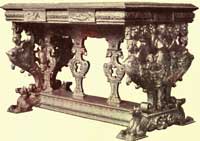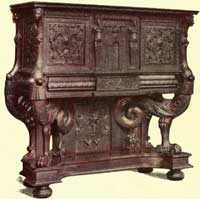Henry II Furniture
The Henri II furniture style is characteristic for the reigns of the last Valois kings. It covers a period starting under the reign of Henry II, the son of Francis I., and lasted until the beginning of the 17th century. During this period, great French architects and sculptors applied their own ideas to the imported Italian principles, creating the original Henry II style. And, talking about the development of the new style, we may also note that the taste and influence of Diane de Poitiers, the mistress of Henry II, cannot be neglected.
The period was characterized by an intense artistic activity, which led to the appearance of albums of engravings with designs for monuments, furniture, and decorative sculpture, all inspired by classical antiquity. The authors of these collections of engravings were Jacques Androuet du Cerceau, a Parisian, and Hugues Sambin, a Burgundian. They published the albums in their towns of residence, Paris and Dijon.
Henry II furniture style, the result of two schools
The works of these two artists allow us to divide the furniture produced in France in the second half of the 16th century into two schools, that of Île de France, and that of Burgundy.

Henry II Table - School of Hugues Sambin
Second half of the 16th Century
The schools defining the Henry II style can be distinguished by their approach to carving and the details of furniture ornamentation. The school of du Cerceau was inclined more towards the grace of line and fine detail, while the Burgundian style displayed a lavish carving meant to suggest richness. The Île de France school admired the elegant sculpted goddesses of Jean Goujon, of Italian inspiration, while the carving of the school of Sambin preferred muscular satyrs, lions’ heads, and eagles.
Henry II furniture style displayed an architectural character, as did its Gothic predecessor. For example, the armoires had generally four folding-doors, two above and two below, separated with pilasters such that they were imitating an architectural façade. The architectural effect was enhanced even further by the presence of niches containing statuettes. In the lavish manner characteristic of the Henry II style, sometimes figures were painted in gold.
Henry II style added new details in furniture carving, including strap and band, pierced shield, arabesque, lozenge, cartouche, with shell and scroll introduced latter. Favorite motifs were the winged chimeras and the caryatids of mythological inspiration.
The beds were either of rectangular shape, with four balusters supporting a canopy, and the carving of the feet representing griffins, or narrower at the feet than at the head, and having only three balusters to support the canopy, two at the head and one at the foot, representing a man or a woman standing, resting on a T-shaped pedestal.
Henry II style tables were rectangular or round. Especially the rectangular tables, belonging to both schools, were richly carved, with the motifs of chimeras and caryatides, and even colonnades and longitudinal arcades, which gave them the same intense architectural feeling.
The artists who took their decorative motifs from the albums published by the two masters ended up in carving their works using motifs from both schools.
There are Henry II furniture pieces where the Dianas inspired by the works of Jean Goujon, motif characteristic mostly of the Cerceau school, are found side by side with the satyrs of Burgundian origin.

